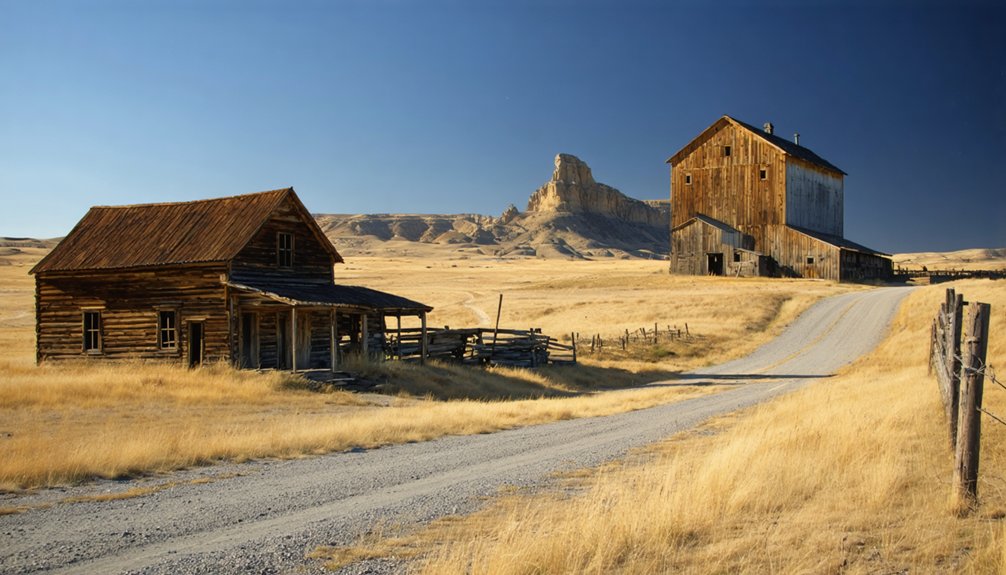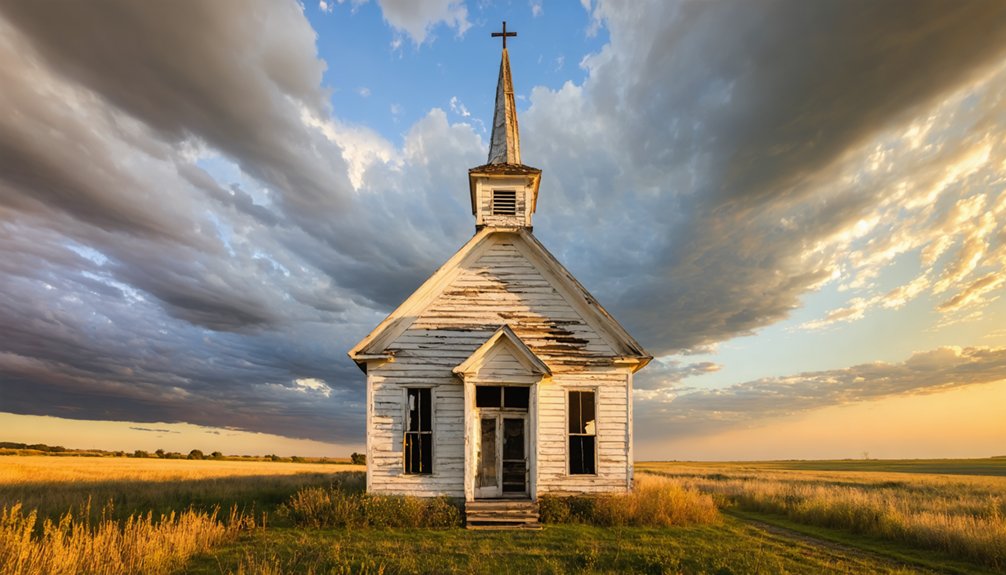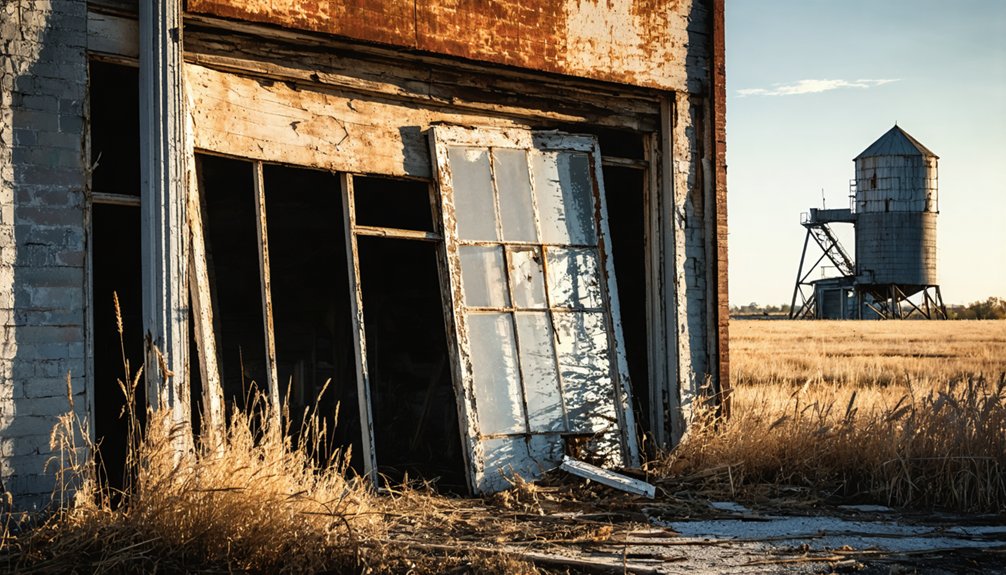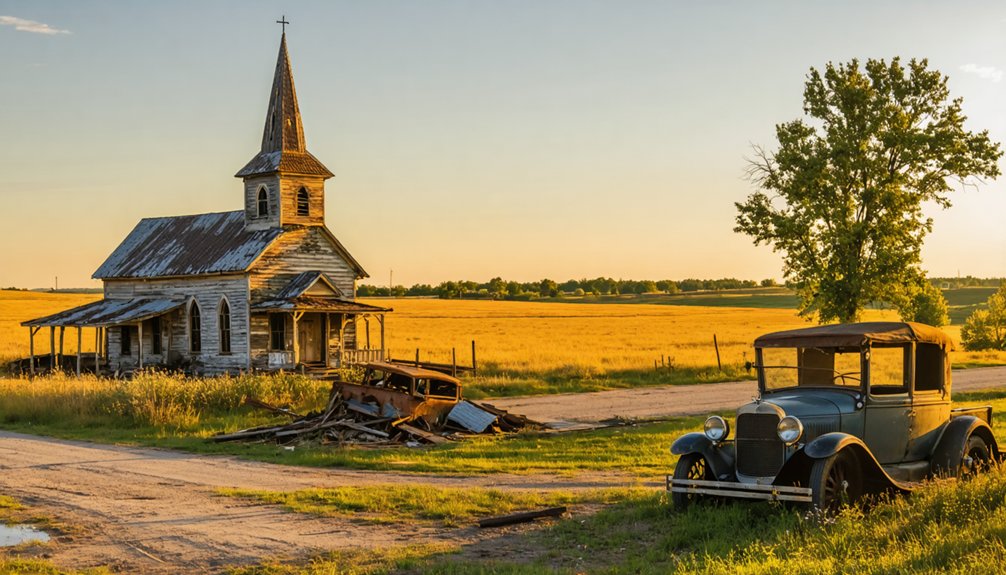You’ll discover Victoria nestled in South Dakota’s Black Hills region, where it emerged as a gold mining settlement in the late 19th century. At its peak around 1900, this remote community housed 27 residents and supported essential businesses including a post office, bars, and general stores. Life revolved around underground mining operations at 5,600 feet elevation, with workers enduring grueling shifts and harsh winters. Today’s deteriorating structures and foundations tell a compelling story of boom-and-bust in the American West.
Key Takeaways
- Victoria was a late 19th-century mining town in South Dakota’s Black Hills region, established during the area’s gold rush period.
- The town reached its peak population of 27 residents around 1900, supported by gold mining operations at the Victoria Mine.
- Essential businesses included a post office, bars, general stores, and mining-related services during the town’s active years.
- Located at 5,600 feet elevation, the Victoria Mine transitioned from surface to underground mining methods in the 1880s.
- Today, Victoria stands abandoned with deteriorating structures and foundations marking where businesses once operated during its mining heyday.
Origins and Early Settlement
During the late 19th century, Victoria emerged as a small settlement within South Dakota’s Black Hills region, strategically positioned along transportation routes that served the area’s burgeoning mining operations.
Like many frontier towns of its era, Victoria’s early settler experiences revolved around supporting the mining workforce and providing essential services to travelers.
You’ll find that Victoria’s initial population consisted of miners, their families, and various tradespeople who established the town’s basic infrastructure.
Similar to other settlements that became Black Hills ghost towns, Victoria’s development was closely tied to the success and eventual decline of mining activities in the region.
These pioneers built general stores, saloons, and rudimentary shelters while facing the challenges of harsh winters and limited resources.
The settlement’s location near stagecoach lines and early railroads proved vital for survival, though the rugged terrain and scarce water sources tested the resolve of these early residents.
The settlers’ determination echoed those who came under the Homestead Act, seeking new opportunities and freedom in the untamed Dakota Territory.
Mining Operations and Economic Growth
While gold served as Victoria’s primary economic driver, silver extraction provided an important secondary revenue stream for the mine’s operations in Lawrence County.
Located at 5,600 feet elevation, Victoria Mine exemplified the challenging conditions faced by Black Hills mining operations of the era.
The mine’s original private ownership status remains unchanged since its operational period, according to historical records.
You’ll find that Victoria Mine, like many Black Hills operations, shifted from surface mining to underground methods as easily accessible deposits were depleted by the 1880s.
The mine’s gold extraction methods likely evolved with mining technology advances of the era, including stamp mills and cyanide processing to handle the region’s typically low-grade ore.
While specific production volumes aren’t documented, Victoria’s impact remained modest compared to the dominant Homestake Mine nearby.
As with many small Black Hills operations, Victoria’s economic viability eventually declined due to exhausted high-grade ore deposits and rising operational costs, leading to its closure by the early 1900s.
Life in Victoria’s Peak Years
During Victoria’s peak years around 1900, you’d have found a close-knit community of about 27 residents, mostly miners and their families, going about their daily routines centered on the mining work schedule.
The town supported essential businesses including a post office established in 1887, along with the bars and general stores typical of Black Hills mining camps. Like other ghost town sites, the area today shows varying states of disrepair and abandonment. The Victoria I Mine was a prominent feature of the landscape, with its distinctive tunnel cut into the hillside above the town.
You could have experienced the strong social bonds formed through community gatherings and events that helped residents cope with the harsh realities of frontier mining life.
Daily Mining Town Life
Life in Victoria’s peak years centered around the demanding rhythm of underground gold mining, where workers endured grueling shifts with basic safety equipment and constant hazards.
You’d find miners’ daily routines revolving around specialized roles – from drillers breaking rock to timbermen reinforcing tunnels. After long hours underground, you’d return to modest wooden homes or, if single, to crowded bunkhouses near the mines.
Miner families drew water from creeks for household needs while relying on general stores for essentials.
You’d gather with neighbors at local saloons or common halls for much-needed social relief. When you weren’t working, you might visit the basic school or church that helped stabilize community life.
Despite harsh conditions, auxiliary trades like blacksmithing and carpentry kept the town’s economy moving.
Business and Trade Operations
As Victoria’s mining operations expanded, you’d find a bustling network of businesses emerging to serve the growing population.
Like other Black Hills towns, Victoria’s commercial success depended heavily on established trade networks and transportation routes that connected the community to crucial supply hubs.
The town’s core business district would have included:
- A general mercantile supplying mining equipment and daily necessities
- Boarding houses and hotels for the transient workforce
- Blacksmith shops maintaining essential mining machinery
- Banking services handling payroll and transactions
- Transportation services connecting to regional stagecoach and rail lines
Similar to how Bijou Hills bank once served its community before decline, you’d witness a constant flow of goods and people through these businesses, as miners, merchants, and travelers participated in Victoria’s local economy.
The town’s commercial activity mirrored the typical pattern of Black Hills mining communities, where business operations adapted to serve the changing needs of the workforce.
Social Activities and Community
While miners toiled in Victoria’s depths, a vibrant social fabric wove through the town’s daily life. You’d find the heart of community gatherings at the Lutheran and Methodist churches, where locals came together not just for worship, but for festivals and social events.
The school served as another hub of activity, hosting plays, celebrations, and meetings that brought families together. Like many of South Dakota’s nearly abandoned towns, Victoria’s population would eventually dwindle to single digits. Researchers have documented 245 ghost towns throughout South Dakota’s history, highlighting the common fate of many mining communities.
During Victoria’s peak years, you’d experience a rich tapestry of social activities – from barn dances and community picnics to seasonal ranching events at the stockyards.
The post office buzzed with news and gossip, while traveling salesmen brought fresh stories from beyond.
This social cohesion, built around religious life, education, and ranching culture, created strong bonds that defined Victoria’s character and kept its community closely knit.
Geographic Location and Terrain

Located in the eastern region of South Dakota, Victoria exemplifies the quintessential Great Plains landscape with its gently rolling prairies and rich agricultural terrain.
The topographical features reflect the area’s natural character, where you’ll find fertile soil perfect for farming and scattered waterways that sustain the local ecosystem. The extensive network of dirt roads provides essential access for overlanding enthusiasts exploring the region.
- Rolling plains stretch across the horizon, creating an endless sea of grass and crops
- Rich prairie soil supports extensive agricultural operations
- Small streams and rivers weave through the landscape
- Lower elevation compared to surrounding territories
- Limited natural resources, unlike the mineral-rich Black Hills region
The terrain’s open character allows you to experience vast, unobstructed views typical of Great Plains communities, where the land meets the sky in a dramatic display of nature’s grandeur.
These geographic features have historically shaped the area’s agricultural development and settlement patterns.
Population Changes and Decline
The dramatic population shifts in Victoria mirror those of many South Dakota ghost towns that experienced rapid growth and eventual decline during the late 19th century.
Early population trends show an influx of settlers, prospectors, and railroad workers drawn by mining opportunities and railroad construction around 1900.
Like its neighboring towns, Victoria’s demographic shifts followed a familiar pattern. As mining activities dwindled and railroad operations decreased, you’d have seen the population steadily declining.
The harsh winters and lack of employment alternatives accelerated the exodus by mid-20th century. While exact numbers aren’t documented, comparable towns in the region dropped from hundreds of residents to fewer than twenty.
The community’s social fabric unraveled as schools, churches, and other institutions closed, leaving just a handful of families to maintain what remained of Victoria’s once-vibrant population.
Notable Buildings and Structures

Standing amidst Victoria’s empty streets, several notable buildings offer glimpses into the town’s former liveliness. The architectural styles reflect practicality over ornate design, with simple structures that once served the community’s daily needs.
While preservation efforts remain minimal due to the remote location, you’ll find these historical remnants still tell compelling stories of Victoria’s past.
- Deteriorating roofs and crumbling walls showcase nature’s reclamation of abandoned structures
- Original building foundations mark where thriving businesses once stood
- Safety concerns limit access to certain structures due to their unstable condition
- Historical integrity remains in select buildings despite ongoing decay
- Tourist interest continues to draw visitors seeking authentic ghost town experiences
These structures serve as silent witnesses to Victoria’s transformation from a bustling community to a representation of western expansion’s impermanence.
Mining Legacy in the Black Hills
While Victoria’s fate intertwined with the broader Black Hills mining legacy, the region’s gold rush began in 1874 when Custer’s expedition violated the 1868 Treaty with the Sioux.
You’d find early prospectors focusing on placer gold in stream beds near French Creek and Deadwood Creek, but by 1876, they’d shifted to hard-rock mining.
Mining technology evolved rapidly from basic placer methods to more sophisticated processes.
You’ll recognize the impact of innovations like the cyanide process, which revolutionized gold extraction from low-grade ore.
The environmental impact was severe – scarring landscapes, polluting rivers, and disrupting sacred Lakota lands.
The most significant operation, Homestake Mine, produced 10% of the world’s gold over 125 years before closing in 2001, leaving behind both economic prosperity and environmental challenges.
Present-Day Site Conditions

Beyond the mining legacy that shaped Victoria’s rise and fall, today’s site bears witness to decades of abandonment and natural reclamation.
You’ll find the town’s remains slowly returning to nature, with environmental reclamation taking its course through vegetation growth and wildlife return.
Site accessibility varies depending on weather conditions and road maintenance, particularly during South Dakota’s harsh seasonal changes.
Current conditions at Victoria reflect the typical ghost town characteristics:
Victoria stands as a testament to ghost town decay, where abandoned buildings and empty streets tell stories of a bygone era.
- Deteriorating structures affected by wind, rain, and extreme temperatures
- Natural vegetation gradually overtaking former building sites
- Wildlife returning to reclaim their original habitat
- Historical structures requiring preservation efforts
- Limited infrastructure remaining from the original settlement
The site’s present state offers a stark reminder of how quickly nature can reclaim human settlements once they’re abandoned, making it an intriguing destination for those interested in historical exploration.
Frequently Asked Questions
Were There Any Major Accidents or Disasters in Victoria’s Mining Operations?
Like a faded photograph lost to time, you won’t find records of major mining accidents or disaster reports from Victoria’s operations. Historical data suggests the town experienced fewer serious incidents than larger mining centers.
What Happened to the Original Residents After Victoria Became Abandoned?
You’ll find that most residents left during demographic shifts, seeking work in larger towns and cities. While specific resident stories are scarce, evidence suggests they scattered throughout South Dakota’s growing communities.
Are There Any Artifacts or Personal Belongings Still Found Today?
Sadly, zero confirmed artifact discoveries exist. You won’t find documented evidence of personal belongings from Victoria, as no official excavations, surveys, or artifact collections have been publicly recorded or preserved.
Did Victoria Have a School or Church During Its Active Years?
You’ll find no confirmed records of a school or church community in Victoria’s history. Due to limited documentation, we can’t definitively say whether these institutions existed during its active years.
Was There Any Significant Native American Presence Before Victoria’s Establishment?
Where there’s smoke, there’s fire – Native tribes like the Sioux had deep cultural significance in the area, particularly the Lakota who hunted buffalo and maintained spiritual connections before European settlement drastically changed their territory.
References
- https://en.wikipedia.org/wiki/List_of_ghost_towns_in_South_Dakota
- https://explore.digitalsd.org/digital/collection/WPGhosttown/id/7519/
- https://www.sdpb.org/rural-life-and-history/2023-08-21/some-black-hills-ghost-towns-and-their-origins
- https://www.youtube.com/watch?v=Glucs_Rq8Xs
- https://www.sdhspress.com/journal/south-dakota-history-2-2/some-black-hills-ghost-towns-and-their-origins/vol-02-no-2-some-black-hills-ghost-towns-and-their-origins.pdf
- https://www.youtube.com/watch?v=_0WNYsFLSLA
- https://icatchshadows.com/okaton-and-cottonwood-a-photographic-visit-to-two-south-dakota-ghost-towns/
- https://www.blackhillsbadlands.com/blog/post/old-west-legends-mines-ghost-towns-route-reimagined/
- https://openprairie.sdstate.edu/etd/4061/
- https://www.powderhouselodge.com/black-hills-attractions/fun-attractions/ghost-towns-of-western-south-dakota/



